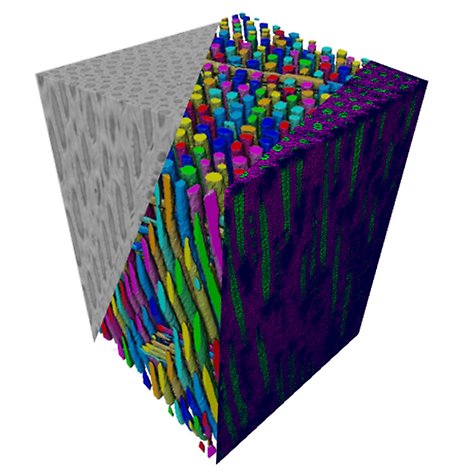Computer modelling reveals the true behaviour of wood

Sara Florisson is most interested in the evolution of the so called hygro-mechanical behaviour of wood due to the effects of global warming. Photo: Anneli Björkman
How is wood affected by climate change? In a project funded by the Swedish Research Council, Sara Florisson, researcher in applied mechanics, is investigating how climate change affects the moisture dependent mechanical properties of wood.

Example of a Norway spruce specimen where the cell walls are analysed.
Last autumn, Sara Florisson was awarded a four-year establishment grant from the Swedish Research Council's annual call for proposals in natural and engineering sciences. Originally from the Netherlands, she received a postdoc position at the Department of Materials Science at Uppsala University in 2022. Her research focus is on understanding the behaviour of wood, especially when exposed to an interaction of mechanical loads and changes in relative humidity and temperature.
"Wood is a very versatile material, but it has a lot of natural variation such as knots and density differences, which affect its behaviour and make it an interesting challenge to simulate.”
Analysing the nano- and microstructure of wood
One of the techniques Sara Florisson uses to observe the microstructure of wood is called finite element modelling. In a computer programme, she divides the wood material into cubes and solves a mathematical equation for each cube. By solving it for all cubes, she can get an idea of the behaviour of a larger object, such as the cellular structure of wood.
But to understand the behaviour inside the cell wall and its chemical components such as lignin, hemicellulose and cellulose, the cell wall needs to be broken down to its smallest components. This is done with computer simulations such as atomistic modelling with molecular dynamics.
"We can actually simulate lignin, hemicellulose and cellulose and see how they react when we send in water molecules and subject them to a certain mechanical load such as compression," says Sara Florisson.
Using X-ray technology
She also hopes to investigate this hygro-mechanical behaviour of wood using X-ray technology at the ForMAX beamline at the MAX IV synchrotron facility in Lund. There, researchers can conduct non-destructive and high-resolution experiments on forest raw materials. The results from such experiments can aid in constructing the finite element and atomistic models and comparing the simulation results to reality.
The research material is more than 100 years old Norwegian spruce and comes from the German partner TU Munich.
“In Germany, the impact of climate change on wood quality has been studied and it turns out that it is actually decreasing. This has to do with extended growing seasons, higher temperatures and other components of global warming, resulting in lower density and strength.”
Need for sustainability solutions
Today, a lot of hope is attached to wood and its potential uses in everything from buildings and bioenergy to batteries and clothing. Sara Florisson hopes her project will raise awareness of sustainability issues and provide information to help industries manage their production processes.
“If the density and strength were to continue to decrease, we would end up with very poor-quality timber, and in extreme cases, we would have to adjust our timber sorting systems. What we want is to build more efficiently, higher and use a smaller amount of material for the same type of building. This will create a more profitable process so that we can hopefully challenge concrete and other types of building materials that have a greater climate impact.”
Anneli Björkman
Facts about the project
- Last autumn, the project "Multi-scale X-ray based modelling to deepen the understanding of the hygromechanical behaviour of wood affected by climate change" was awarded an establishment grant from the Swedish Research Council within the call Natural Sciences and Engineering Sciences 2023.
- The purpose of the establishment grant is to give junior researchers the opportunity to establish themselves as independent researchers in Sweden.
- The grant period is 4 years and the grant amount is SEK 1 million per year.
